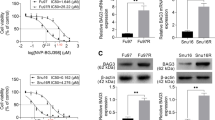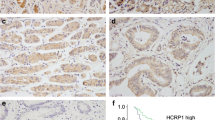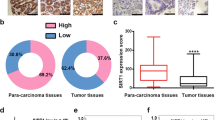Abstract
Gastric cancer, as the fifth most frequent disease and the fourth foremost cause of cancer-related death worldwide, remains a main clinical challenge due to its poor prognosis, limited treatment choices, and ability to metastasize. Combining siRNAs to suppress lncRNA with chemotherapeutic medications is a novel treatment approach that eventually increases the therapeutic efficacy of the drug while lessening its adverse effects. This study was performed with the purpose of examining the impact of inhibiting DLGAP1-AS2 expression on gastric cancer cells’ drug chemosensitivity. AGS cells were cultured as the study cell line and were transfected with an optimum dose of DLGAP1-AS2 siRNA and then treated with oxaliplatin. Cell viability was examined using the MTT technique. Apoptosis and cell cycle were evaluated using Annexin V/PI staining and flow cytometry. Later, the scratch test was conducted to investigate the ability of cells to migrate, and the inhibition of the stemness of AGS cells was further investigated through the colony formation method. Finally, the qRT-PCR technique was used to assess the expression of Bax, Bcl-2, Caspase-3, p53, MMP-2, and CD44 genes. The MTT test indicated the effect of gene therapy with siRNA and oxaliplatin in combination reduced the chemotherapy drug dose to 29.92 µM and increased AGS cells’ sensitivity to oxaliplatin. Also, the combination therapy caused a significant increase in apoptosis. However, it reduced the stemness feature, the rate of cell viability, proliferation, and metastasis compared to the effect of each treatment alone; the results also showed the arrest of the cell cycle in the Sub G1 phase after the combined treatment and a further reduction in the number and size of the formed colonies. Suppressing the expression of lncRNA DLGAP1-AS2 by siRNA followed by treatment with oxaliplatin can be utilized as an effective and new therapeutic technique for gastric cancer therapy.









Similar content being viewed by others
Data availability
The results will be available upon the reasonable request from the corresponding author.
References
André T, Boni C, Mounedji-Boudiaf L, Navarro M, Tabernero J, Hickish T, Topham C, Zaninelli M, Clingan P, Bridgewater J (2004) Oxaliplatin, fluorouracil, and leucovorin as adjuvant treatment for colon cancer. N Engl J Med 350:2343–2351
Bhan A, Soleimani M, Mandal SS (2017) Long noncoding RNA and cancer: a new paradigm. Can Res 77:3965–3981
Biagioni A, Skalamera I, Peri S, Schiavone N, Cianchi F, Giommoni E, Magnelli L, Papucci L (2019) Update on gastric cancer treatments and gene therapies. Cancer Metastasis Rev 38:537–548
Cantile M, Di Bonito M, Cerrone M, Collina F, De Laurentiis M, Botti G (2020) Long non-coding RNA HOTAIR in breast cancer therapy. Cancers 12:1197
Devanabanda B, Kasi A (2022) Oxaliplatin. StatPearls [Internet]. StatPearls Publishing
Gao J-P, Xu W, Liu W-T, Yan M, Zhu Z-G (2018) Tumor heterogeneity of gastric cancer: from the perspective of tumor-initiating cell. World J Gastroenterol 24:2567
Gu Y, Chen T, Li G, Yu X, Lu Y, Wang H, Teng L (2015) LncRNAs: emerging biomarkers in gastric cancer. Future Oncol 11:2427–2441
Gutschner T, Diederichs S (2012) The hallmarks of cancer: a long non-coding RNA point of view. RNA Biol 9:703–719
Joshi SS, Badgwell BD (2021) Current treatment and recent progress in gastric cancer. CA Cancer J Clin 71:264–279
Karimi P, Islami F, Anandasabapathy S, Freedman ND, Kamangar F (2014) Gastric cancer: descriptive epidemiology, risk factors, screening, and preventiongastric cancer. Cancer Epidemiol Biomark Prev 23:700–713
Kumar K, Rani V, Mishra M, Chawla R (2022) New paradigm in combination therapy of siRNA with chemotherapeutic drugs for effective cancer therapy. Curr Res Pharmacol Drug Discov 3:100103. https://doi.org/10.1016/j.crphar.2022.100103
Liu Z, Pan L, Yan X, Duan X (2021) The long noncoding RNA DLGAP1-AS2 facilitates cholangiocarcinoma progression via miR-505 and GALNT10. FEBS Open Bio 11:413–422
Lu J, Xu Y, Xie W, Tang Y, Zhang H, Wang B, Mao J, Rui T, Jiang P, Zhang W (2021) Long noncoding RNA DLGAP1-AS2 facilitates Wnt1 transcription through physically interacting with Six3 and drives the malignancy of gastric cancer. Cell Death Discov 7:255
Lu J (2020) Expression and mechanism of long non-coding RNA DLGAP1-AS2 in gastric cancer. Tumor 153–162
Luo J, Zhang Y, Zheng T, Jing Y, Cao R, Wu M, Fan D, Tao Y, Zhao M (2021) LncRNA DLGAP1-AS2 suppresses the maturation of miR-16 to suppress cell invasion and migration of ovarian cancer cells. https://doi.org/10.21203/rs.3.rs-142142/v1
Machlowska J, Baj J, Sitarz M, Maciejewski R, Sitarz R (2020) Gastric cancer: epidemiology, risk factors, classification, genomic characteristics and treatment strategies. Int J Mol Sci 21:4012
Miao W, Li N, Gu B, Yi G, Su Z, Cheng H (2020) LncRNA DLGAP1-AS2 modulates glioma development by up-regulating YAP1 expression. J Biochem 167:411–418
Mokhtari RB, Homayouni TS, Baluch N, Morgatskaya E, Kumar S, Das B, Yeger H (2017) Combination therapy in combating cancer. Oncotarget 8:38022
Morgan E, Arnold M, Camargo MC, Gini A, Kunzmann AT, Matsuda T, Meheus F, Verhoeven RH, Jo V, Laversanne M (2022) The current and future incidence and mortality of gastric cancer in 185 countries, 2020–40: a population-based modelling study. EClinicalMedicine 47:101404
National Library of Medicine (2024) DLGAP1-AS2: DLGAP1 antisense RNA 2 [Homo sapiens (human)]. https://www.ncbi.nlm.nih.gov/gene?Db=gene&Cmd=DetailsSearch&Term=84777. Accessed 2022
Pantel K, Alix-Panabières C, Riethdorf S (2009) Cancer micrometastases. nature reviews. Clin Oncol 6:339–351
Singh A, Trivedi P, Jain NK (2018) Advances in siRNA delivery in cancer therapy. Artif Cells Nanomed Biotechnol 46:274–283
Society, A.C. Stomach Cancer (n.d.). https://www.cancer.org/cancer/types/stomach-cancer.html
Soltani R, Amini M, Mazaheri Moghaddam M, Jebelli A, Ahmadiyan S, Bidar N, Baradaran B, MotieGhader H, Asadi M, Mokhtarzadeh A (2022) LncRNA DLGAP1-AS2 overexpression associates with gastric tumorigenesis: a promising diagnostic and therapeutic target. Mol Biol Rep 49(7):6817–6826. https://doi.org/10.1007/s11033-021-07038-w
Sung H, Ferlay J, Siegel RL, Laversanne M, Soerjomataram I, Jemal A, Bray F (2021) Global cancer statistics 2020: GLOBOCAN estimates of incidence and mortality worldwide for 36 cancers in 185 countries. CA: Cancer J Clin 71:209–249
Ye DM, Xu G, Ma W, Li Y, Luo W, Xiao Y, Liu Y, Zhang Z (2020) Significant function and research progress of biomarkers in gastric cancer. Oncol Lett 19:17–29
Ye J, Li J, Zhao P (2021) Roles of ncRNAs as ceRNAs in gastric cancer. Genes 12:1036
Acknowledgements
The authors wish to thank the financial support from the National Institute for Medical Research Development (NIMAD) of Iran (project no. 4021422). Also, the authors are thankful for the support of the Immunology Research Center, Tabriz University of Medical Science
Funding
The authors wish to thank the financial support from the National Institute for Medical Research Development (NIMAD) of Iran (project no. 4021422). Also, the authors are thankful for the support of the Immunology Research Center, Tabriz University of Medical Science.
Author information
Authors and Affiliations
Contributions
S.S.A, the first author of the manuscript, performed the experiment, contributed to the cellular and molecular assays, and wrote the manuscript. R.S revised the main text of the manuscript and revised the work critically for important intellectual content. M.A assisted in the cellular and molecular assays and analyzed the data. M.A.H.F revised the main text of the manuscript and revised the work critically for important intellectual content. S.A assisted in the molecular assays. S.N helped with the data categorization and interpreted the results. S.Z.B.M assisted in the cellular assays and revised the main text of manuscript. A.Y and L.N helped with the data categorization and interpreted the results. B.B revised the main text of the manuscript and revised the work critically for important intellectual content. A.A.M, the corresponding author of the manuscript, designed and supervised the project, and revised the main text of the manuscript. The authors declare that all data were generated in-house and that no paper mill was used.
Corresponding author
Ethics declarations
Ethical approval
Not applicable.
Human ethics declaration
Not applicable.
Competing interests
The authors declare no competing interests.
Additional information
Publisher's Note
Springer Nature remains neutral with regard to jurisdictional claims in published maps and institutional affiliations.
Rights and permissions
Springer Nature or its licensor (e.g. a society or other partner) holds exclusive rights to this article under a publishing agreement with the author(s) or other rightsholder(s); author self-archiving of the accepted manuscript version of this article is solely governed by the terms of such publishing agreement and applicable law.
About this article
Cite this article
Azadi, S.S., Safaralizadeh, R., Amini, M. et al. Investigating the effect of LncRNA DLGAP1-AS2 suppression on chemosensitivity of gastric cancer to chemotherapy. Naunyn-Schmiedeberg's Arch Pharmacol (2024). https://doi.org/10.1007/s00210-024-03130-7
Received:
Accepted:
Published:
DOI: https://doi.org/10.1007/s00210-024-03130-7




